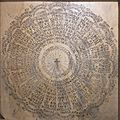Computus facts for kids

Computus is a special word from Latin that means "computation" or "calculation." It's the name for the method used to figure out the correct date for Easter each year. In the early 300s AD, there was a lot of confusion among Christians about when to celebrate Easter, which remembers the Resurrection of Jesus.
Contents
History of Easter Dates
Why Easter Dates Were Confusing
Back in 314 AD, a meeting called the Arles Council decided that all Christians should celebrate Easter on the same day. They said the Pope would set the date and send letters to churches everywhere. But not everyone followed these rules.
The Nicaea Council's Rules
The problem was finally sorted out at a big meeting called the First Council of Nicaea in 325 AD. Here, they made some important rules for celebrating Easter:
- Easter must always be on a Sunday.
- It should not happen on the same day as the Jewish festival of Passover. Passover is celebrated on a specific date, no matter what day of the week it falls on.
- Christians should only celebrate Easter once a year. This was important because the new year used to start around the spring equinox. So, celebrating Easter before the true spring equinox was not allowed.
Even after these rules, there were still some disagreements between the Roman Church and the Alexandrian Church (from Alexandria, Egypt). The Nicaea Council decided that the Alexandrian Church's way of calculating was correct. So, they would figure out the date in Alexandria and then tell Rome. The Roman Church would then share this date with all other Christians.
How Easter is Calculated
| Year | Western | Eastern |
|---|---|---|
| 1982 | April 11 | April 18 |
| 1983 | April 3 | May 8 |
| 1984 | April 22 | |
| 1985 | April 7 | April 14 |
| 1986 | March 30 | May 4 |
| 1987 | April 19 | |
| 1988 | April 3 | April 10 |
| 1989 | March 26 | April 30 |
| 1990 | April 15 | |
| 1991 | March 31 | April 7 |
| 1992 | April 19 | April 26 |
| 1993 | April 11 | April 18 |
| 1994 | April 3 | May 1 |
| 1995 | April 16 | April 23 |
| 1996 | April 7 | April 14 |
| 1997 | March 30 | April 27 |
| 1998 | April 12 | April 19 |
| 1999 | April 4 | April 11 |
| 2000 | April 23 | April 30 |
| 2001 | April 15 | |
| 2002 | March 31 | May 5 |
| 2003 | April 20 | April 27 |
| 2004 | April 11 | |
| 2005 | March 27 | May 1 |
| 2006 | April 16 | April 23 |
| 2007 | April 8 | |
| 2008 | March 23 | April 27 |
| 2009 | April 12 | April 19 |
| 2010 | April 4 | |
| 2011 | April 24 | |
| 2012 | April 8 | April 15 |
| 2013 | March 31 | May 5 |
| 2014 | April 20 | |
| 2015 | April 5 | April 12 |
| 2016 | March 27 | May 1 |
| 2017 | April 16 | |
| 2018 | April 1 | April 8 |
| 2019 | April 21 | April 28 |
| 2020 | April 12 | April 19 |
| 2021 | April 4 | May 2 |
| 2022 | April 17 | April 24 |
Calculating the date of Easter is a bit like solving a puzzle! It involves using a few simple math steps based on the year. This method helps make sure everyone celebrates Easter on the same Sunday.
For years between 1900 and 2100, we use two special numbers: M = 24 and N = 5.
The calculation uses the year you want to find Easter for. You divide the year by certain numbers and look at the leftover amounts (called the remainder). These remainders then help you find the day in March or April.
There are a couple of special cases:
- If the calculation gives April 26, Easter is actually on April 19 instead.
- If the calculation gives April 25, and some specific conditions are met (like certain remainders), Easter is actually on April 18.
The special numbers M and N change for different periods of years. Here's a table to show you:
| Years | M | N |
|---|---|---|
| 1583-1699 | 22 | 2 |
| 1700-1799 | 23 | 3 |
| 1800-1899 | 23 | 4 |
| 1900-2099 | 24 | 5 |
| 2100-2199 | 24 | 6 |
| 2200-2299 | 25 | 0 |
Images for kids
-
This table from Sweden helped people find the date of Easter between 1140 and 1671. It even uses runes as symbols!
-
This diagram shows the date of Easter for 600 years, from the time the Gregorian calendar was created until the year 2200. It was made by Camille Flammarion in 1907.
See also
 In Spanish: Computus para niños
In Spanish: Computus para niños





